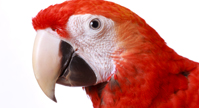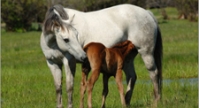Pigeon, Falcon and Owl Herpesvirus
Description:
 Herpesvirus infections in raptors were first documented from Austria in the early 1900s and have since been isolated from free-ranging and domestic birds in Asia, Europe and the United States. Herpesvirus infections in falcons are frequently referred to as "herpesviral inclusion body disease." It is now known that the herpesvirus that causes this disease in raptors is the same as the herpesvirus found in pigeons, "Columbid herpesvirus-1," or CoHV-1.
Infected falcons usually die acutely with no premonitory signs, but may exhibit depression, lethargy and anorexia for 24
to 72 hours before death. Mortality rates in affected birds approach 100% with death usually occurring one to two days
after clinical signs develop. Both young and adult falcons have been found to be susceptible to falcon herpesvirus
infections.
Herpesvirus infections in raptors were first documented from Austria in the early 1900s and have since been isolated from free-ranging and domestic birds in Asia, Europe and the United States. Herpesvirus infections in falcons are frequently referred to as "herpesviral inclusion body disease." It is now known that the herpesvirus that causes this disease in raptors is the same as the herpesvirus found in pigeons, "Columbid herpesvirus-1," or CoHV-1.
Infected falcons usually die acutely with no premonitory signs, but may exhibit depression, lethargy and anorexia for 24
to 72 hours before death. Mortality rates in affected birds approach 100% with death usually occurring one to two days
after clinical signs develop. Both young and adult falcons have been found to be susceptible to falcon herpesvirus
infections.
Although research has shown that the herpesvirus isolated from pigeons, owls, and falcons are virtually identical, the virus does differ from other avian herpesviruses. CoHV-1 only has about 53% nucleotide identity with the finch sequence and 59% identity with the vulture and parrot sequences. Based on the sequencing results, researchers conclude that the currently described pigeon, falcon, and owl herpesviruses are the same virus and is distinct from other known avian herpesviruses.
Transmission:
In raptors, the primary infection of adult birds is thought to occur by ingestion of infected prey, in particular, pigeons. Therefore, feeding of pigeons infected with CoHV-1 to falcons and owls should be avoided.
Symptoms:
In pigeons, clinical disease is not always evident prior to death but, if present, may involve depression, anorexia, conjunctivitis, oral and pharyngeal ulceration, dyspnea, and diarrhoea with a duration of a few hours to as long as one week. Lesions generally include one or more of the following: upper respiratory tract inflammation and ulceration, upper gastrointestinal tract inflammation and ulceration, hepatic necrosis, splenic necrosis, and renal necrosis.
Infected falcons usually die acutely with no premonitory signs, but may exhibit depression, lethargy and anorexia for 24 to 72 hours before death. Mortality rates in affected birds approach 100% with death usually occurring one to two days after clinical signs develop. Both young and adult falcons have been found to be susceptible to falcon herpesvirus infections.
Prevention:
Feeding of pigeons infected with CoHV-1 to falcons and owls should be avoided. A falcon herpes vaccine does exist. Consult your veterinarian for prevention options.
Sample Type:
Tracheal and/or throat swabs are accepted sample types for pigeon, falcon and owl herpesvirus genetic analysis. Post-mortem samples of liver, spleen, or kidney tissue in a sterile container with alcohol may be submitted. Post-mortem swabs may also be submitted.
Limitations:
As with any genetic test, new mutations may occur in the viral genome that could affect the assay. Therefore, it may be difficult to detect all subtypes. Sample collection plays a pivotal part in the overall accuracy of the test, so please use caution and follow the instructions carefully.
Submit a Sample for Testing:
To submit a sample download a test submission form at Downloads
Cost per sample is $24.50. Please see our fee schedules below for bulk and combination rates.










